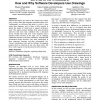26354 search results - page 27 / 5271 » How we refactor, and how we know it |
WPES
2006
ACM
14 years 1 months ago
2006
ACM
Connections in distributed systems, such as social networks, online communities or peer-to-peer networks, form complex graphs. These graphs are of interest to scientists in field...
ITS
2000
Springer
13 years 11 months ago
2000
Springer
With the rise of VR, the internet, and mobile technologies and the shifts in educational focus from teaching to learning and from solitary to collaborative work, it's easy (bu...
CHI
2007
ACM
14 years 8 months ago
2007
ACM
Software developers are rooted in the written form of their code, yet they often draw diagrams representing their code. Unfortunately, we still know little about how and why they ...
ATAL
2010
Springer
13 years 8 months ago
2010
Springer
It is to date an open question to know how the updating methods affect the evolution of a multi-agent system. This question has been tackled for various complex systems such as ce...
RE
2007
Springer
14 years 1 months ago
2007
Springer
Small companies form a large part of the software industry, but have mostly been overlooked by the requirements engineering research community. We know very little about the techn...

